|
|
|
|
 |
|
In this week’s issue: Satellites spot curious sights across the world’s oceans, we celebrate Pride Month with some dazed rainbow pictures, and an eruption leaves a trail of ash in The Philippines. |
|
|
|
FEATURED STORY
Oceans Part 2
We may have named it Earth, but the planet’s most defining feature is water. It's called the Blue Marble for a reason: oceans, ice caps, rivers, lakes... you name it. Collectively, aquatic bodies cover around 71% of the planet’s surface. And from space that percentage is even greater if you count the part of its system in motion over the land—clouds. So on any given day satellites are capturing a lot of images of water and the great oceans that contain most of it. And perhaps not surprisingly, they capture some fascinating sights over them too.
| 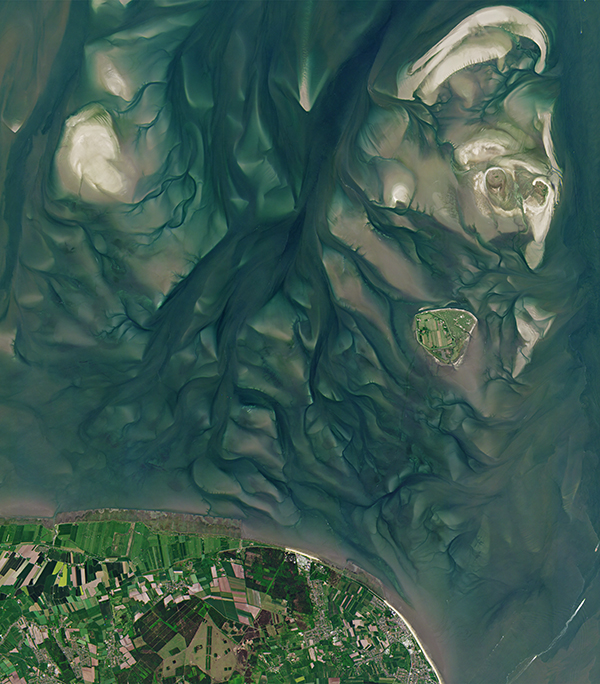 | PlanetScope • Wadden Sea • May 15, 2019 |
Summer is fast approaching in the Northern Hemisphere, and all the signs are here: warming weather, beach crowds, and bad tan lines. The ocean’s gravitational pull has always been strong—with over a third of all humans living within 100 km (62 mi) of a coastline—though it’s especially strong during these summer months. But for those of us who watched the movie Jaws too young and are still afraid of large bodies of water, we prefer the view from a distance. And the view from orbit hundreds of kilometers away sounds just about far enough.
| 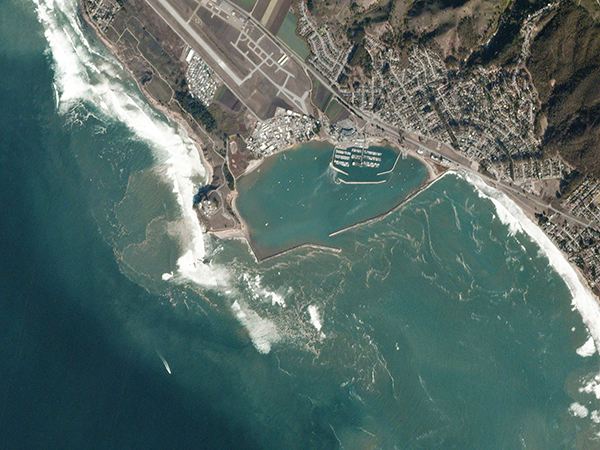 |
|
Next week we’re covering drought, so the issue is going to be dry—literally, not figuratively. In preparation we figured we’d pick back up where we left off a few months ago and wet your appetites with some extraordinary sights we’ve captured near the coastlines. And World Oceans Day was yesterday, so we’re in a marine mood.
|  |
|
Like a bathtub with jets, ocean waters are kept in constant motion by currents. They transport everything from heat to nutrients around the globe, influencing both life on land and at sea. And if you feel that the bathtub analogy is silly, consider the fact that in 1992 a cargo ship container spilled almost 30k rubber ducks into the ocean and that oceanographers used them to study ocean currents for years afterwards. Although they’re often deep, currents can sometimes be seen in water shallow enough to spot, like the one seen here in Nador.
|  |
PlanetScope • Nador, Morocco • January 3, 2017 |
The oceans are a wild and unruly domain, but we're seafaring people that have been riding the currents, waves, and winds for millennia. In the modern era we’ve upped the ante by creating a global shipping network that’s as impressive as it is complex. Cities around the world have distinguished themselves as trading posts, with exquisitely-colored ports to show for it.
|  | SkySat • Freeport, The Bahamas • February 3, 2021 |
But the same qualities that make the oceans so great for global shipping make them a perfect harbor for illegal activity. They’re one of the world’s final frontiers: borderless, ungovernable, and unpredictable. As the war in Ukraine surpasses 100 days of combat, new reports show that Russia is sending cargo vessels with stolen wheat to a number of countries struggling with drought-related food shortages. One of the ships carrying stolen wheat, the Matros Pozynich, was spotted by satellite at a port in Latakia, Syria after traveling through European waters. The ship can be seen right in the middle of the image below.
| 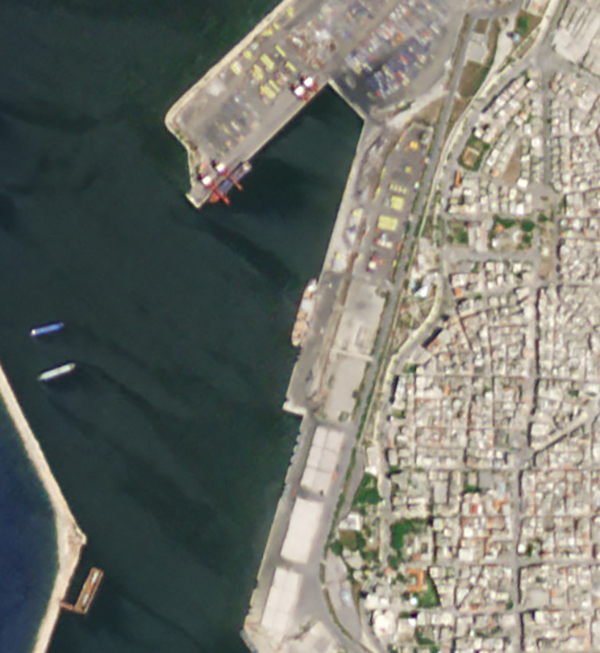 | PlanetScope • Latakia, Syria • April 29, 2022 |
|
Where there’s opportunity, there’s likely to be conflict. And the oceans are no exception. They’re simultaneously battleground and graveyard, with fighting at the surface and casualties sunk to the murky depths. Thousands of warships prowl the seas as countries vie for marine power. And while their movements can be observed by satellites, certain ships, like nuclear submarines, are more elusive. Two years ago, a Chinese nuclear submarine was spotted entering an underground-underwater cave on Hainan Island.
| 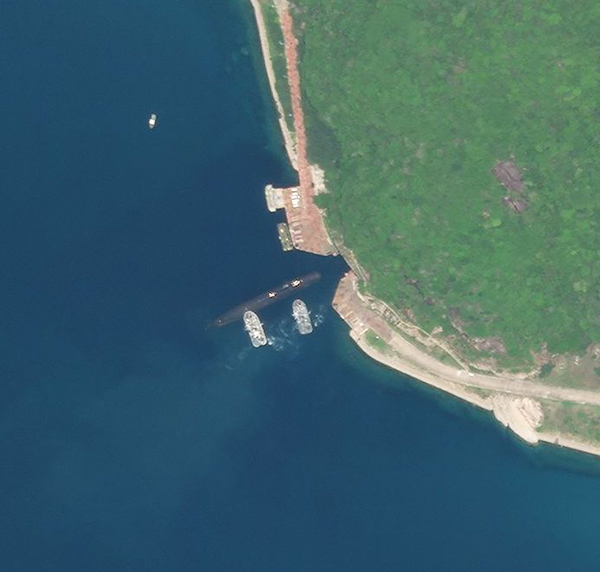 | SkySat • Yulin Naval Base, Hainan Island, China • August 18, 2020 |
Bodies of water are constantly changing: rising and falling, expanding and receding, eroding and evaporating. And as they change they transform environments around them, sometimes uncovering artifacts from the past. Last year, seismic tremors raised the seabed surrounding the Japanese island of Iwo Jima, pushing a number of barnacle-covered transport ships submerged by U.S. forces in the 1940s to create breakwater for a harbor up onto land.
|  | 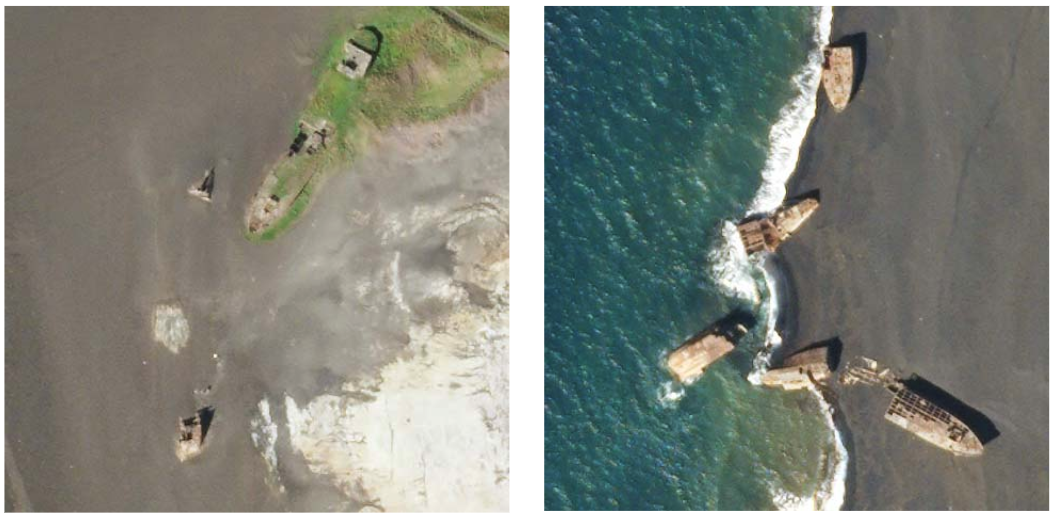 |
SkySat • Iwo Jima, Japan • October 22, 2021 |
Water is a unique substance in that it’s less dense as a solid than as a liquid, which explains why ice cubes float in a glass of water or why an iceberg the size of Washington D.C. can float in the South Atlantic Ocean. Two years ago, iceberg A68d broke off its parent iceberg A68—which was a bit larger than Delaware—as ocean currents pulled it from Antarctica to South Georgia Island.
| 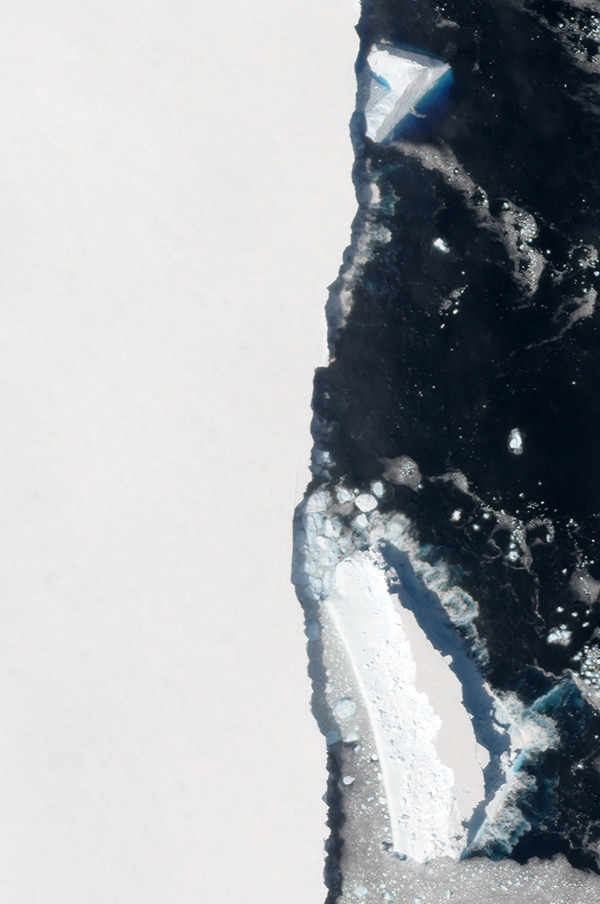 | SkySat • Iceberg A68d • December 18, 2020 |
The oceans contain abundant life and are a pillar for global ecosystems. While you can only directly see larger marine organisms (like whales or military dolphin pens) from space, you can sometimes see the impressions they leave in the waters. Like herrings during the spring, when they gather in the tens of thousands near coastlines to reproduce, turning the waters a cloudy white with their milt and eggs.
| 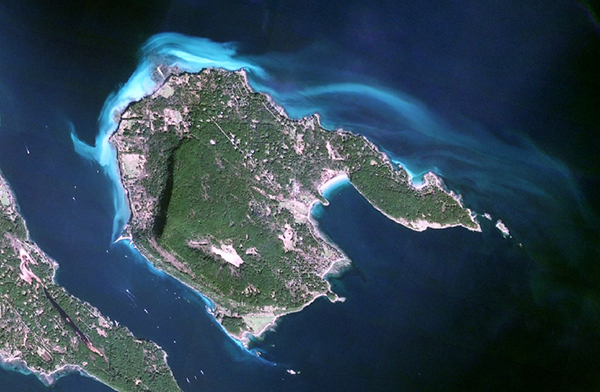 |
PlanetScope (via Lianna Gendall) • Hornby Island, British Columbia, Canada • March 6, 2022 |
Earth is the only known planet to have large bodies of water present on its surface—a planetary feature that’s considered a prerequisite for life. Meaning, in other words, it’s the most special place we’ve ever discovered. Yet we don’t treat it as such. Our actions are warming the oceans, melting the ice, and collapsing aquatic ecosystems. As with all areas massive in scale, satellites can help monitor and provide insight where nothing else can. But it’s just one piece of the puzzle needed to address the sea of issues we’ve set in motion. And even if we do discover another planet with water on its surface, we’re in the boat of keeping our Earth healthy and 71% blue.
Pictured: A stream empties water into a salty lake in the Tibetan Plateau. To the right, underneath the surface, is a former valley drowned by the rising lake level.
|
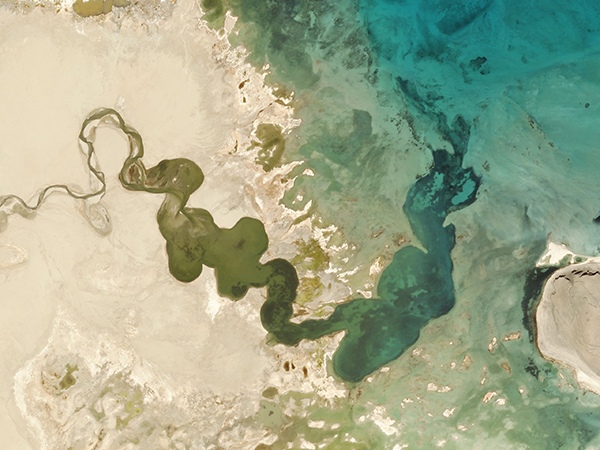 | SkySat • Pangong Tso, India • April 27, 2020 |
|
|
|
Satellite Explainer: Dazed and Confused
June is Pride Month, a time to commemorate the Stonewall riots of 1969 and to celebrate the LGBTQ community. The rainbow flag is an icon of pride, so we figured we’d pair our own celebration with a satellite explainer on some of our most colorful images, internally called Dazed Dove Pics. These glitch-like, vivid, and prismatic images don’t often see the light of day, but are instead shared around our Slack channels for our own amusement, appreciation, and edification.
|  |
Our satellites take over 3 million images a day, so they’re bound to make occasional mistakes during automatic image-processing. Pixels in a camera sensor only detect the intensity of any light that hits it, but the sensor has filters that restrict the light in certain parts of the camera to see a single color. The images originally look black and white because the pixels are measuring each color separately. During processing all the pixels are lined up and put into a composite, color image. But when lined up incorrectly, rainbows appear. |
 | This doesn’t explain the whole picture, but it adds a bit of color to what is happening behind the scenes. So as it turns out, bad (but spectacular) data is at the end of the rainbow. Happy Pride and enjoy! |
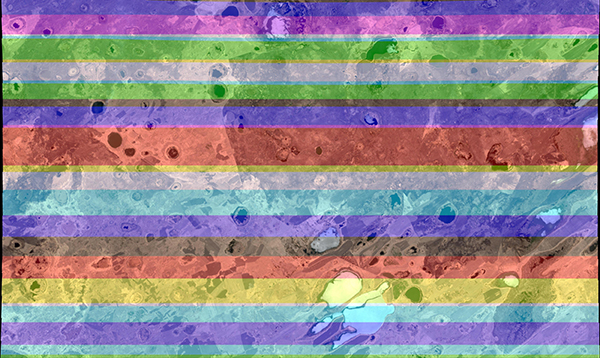 |
|
 |
|
 |
|
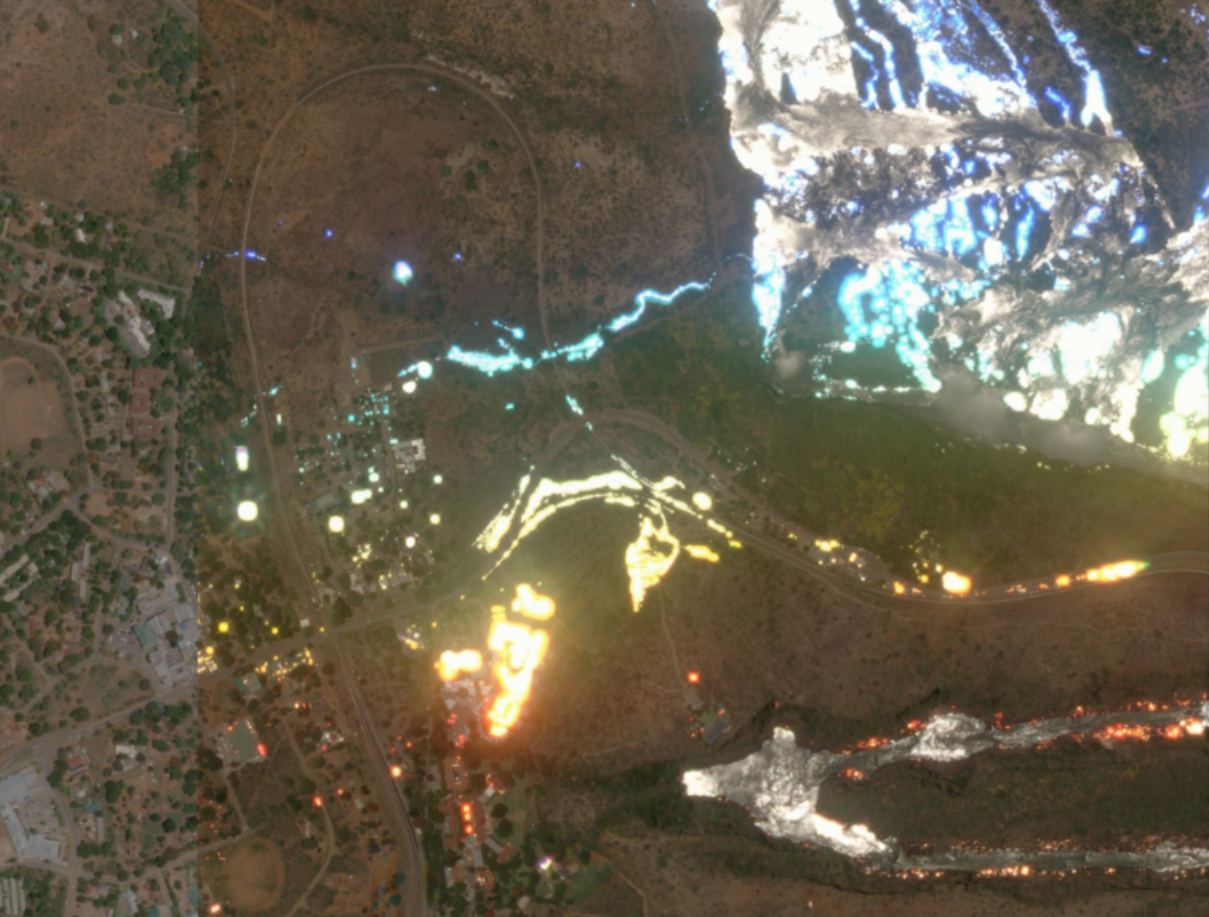 |
|
|
|
|
Change of the Week: Bulusan Volcano
The Bulusan Volcano in Sorsogon, The Philippines erupted on June 5th, spewing a giant chimney-like column of ash 1 km (0.6 mi) into the air. Professor Simon Carn, a volcanologist at Michigan Tech spotted the aftermath in PlanetScope data a day after the eruption. The ash covered normally verdant towns, roads, and vegetation a dull gray. Take a look between the clouds to spot the strip of ash settled directly west of the volcano.
| 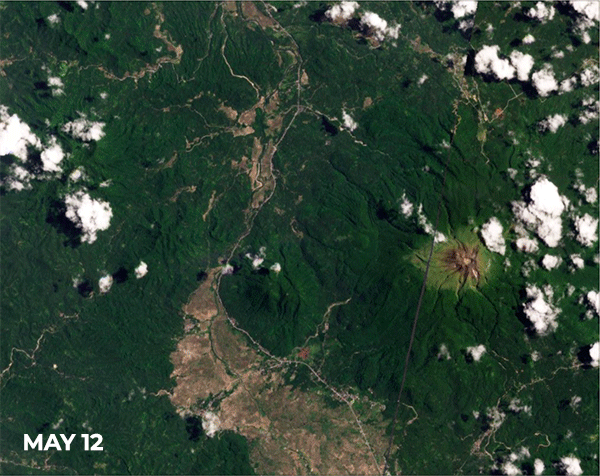 | Unprocessed PlanetScope • Bulusan Volcano, The Philippines • May 12 - June 6, 2022 |
|
|
|
|
Correction from Previous Issue
Last week we incorrectly labeled an image of mass graves in Staryi Krym. The town of Staryi Krym is located outside of Mariupol, Ukraine and not in Crimea as we wrote in the caption. We apologize for the error and we thank our readers for catching it.
|
|
|
|
|